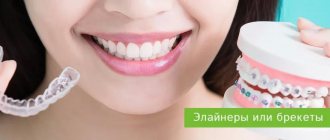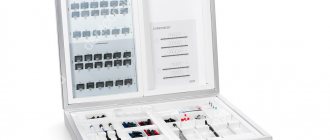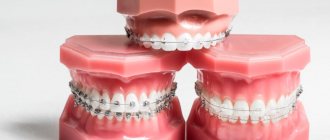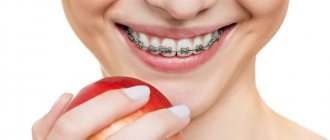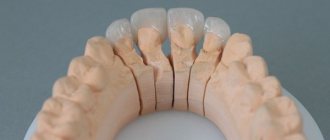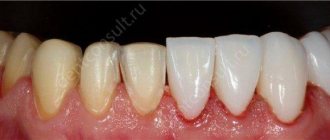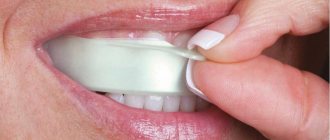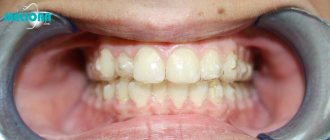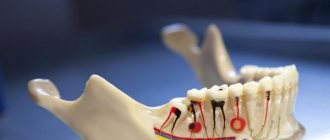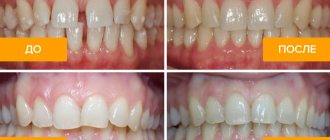| COMMON DATA | ALINERS | BRACKETS | VENEERS |
| What they look like | transparent mouth guards for temporary wear | temporary sticker on teeth + wire | permanent sticker on teeth |
| Color spectrum | transparent | the most diverse | white or the color of the patient’s teeth |
| Material | polymer | metal/polymer/ceramics | polymer/porcelain/ceramics |
| Transparency | Yes | No | Yes |
| Possibility of metal allergy | No | Yes | No |
| Suitable for children under 16 years old | no But the technology is being developed for children from 7 years old. | Yes | not earlier than the formation of enamel of permanent teeth is completed |
Seriously speaking, it is best to be treated with aligners
Yes, I want to book a free consultation on aligners in my city!
If braces and veneers - we all understand that they are visual and what they are, then aligners
- These are the lightest transparent mouthguards made of solid polymer.
When you put on the aligners, you see your entire dentition (the aligners become invisible).
And this is a plus for aligners
Also, the advantages of aligners include the absence of allergies, just like veneers. Braces cannot boast of this.
By the way, you can find out in 1 minute whether aligners are right for you or whether doctors will forcibly offer only braces: you need to answer only 9 express questions
.
But the main general advantage of braces is that they can be installed in childhood. Although, according to the scientific development department of Star Smile, aligners are now being developed for children from 7 years of age. If this works out, then the undisputed leadership in the overall comparison will go to the aligners.
Types of aesthetic dentistry
Depending on the aesthetic task, approaches to work may be different. If a complete change in the appearance of the entire dentition is required, then usually one procedure cannot get rid of it. Complex work of several specialists will be required: gnathologist, orthodontist, surgeon and orthopedist.
If we are talking about less global changes, for example, the restoration of one or more destroyed units, chipped front teeth or changing the appearance of the smile area, the following procedures may be used:
- Restoration with composite materials
- Restoration of chewing teeth with inlays
- Aesthetic (artistic) restoration of anterior teeth
- Aesthetic restoration with veneers
Teeth whitening also falls within the scope of aesthetic dentistry.
Preparation for treatment with braces, veneers and aligners
| Preparing for treatment | ALINERS | BRACKETS | VENEERS |
| Virtual setup: a computer program allows you to create a three-dimensional model of the dental system | Yes | No | Yes |
| Opportunity to discuss the results and progress of treatment with the doctor | Yes | No | Yes |
| Patient participation in treatment | Yes | No | No |
When a patient sees on the computer his future smile, in which all the teeth are aligned, it seems fantastic. But in fact, the 3D virtual setup is a super program from Star Smile, considered one of the best in the world and used by clinics in more than 25 countries
world and
100 cities of Russia
. This program for visualizing the future result of treatment using more than 40 parameters simulates all processes of bite correction and allows you to accurately plan treatment. Exactly with the same great result that the patient will see BEFORE the start of treatment.
Braces do not have this option - all treatment is carried out blindly, and the patient can only live in hope for the future.
And a huge plus in preparing and conducting treatment is the participation of the patient. The aligners are removable and are completely under the control of the person being treated. Therefore, the answer to the question: “What is better - braces or aligners at the initial stage?” — aligners.
Ceramic veneers: patient reviews
Patient reviews of ceramic veneers in most cases are enthusiastic, because they really can make you the owner of a Hollywood smile. But, this is only if your veneers are done by a truly highly qualified dental technician. In addition, it is very important that the clinic you go to has its own dental laboratory.
This will allow the prosthodontist and dental technician to make decisions together while standing at the chair, and the dental technician will then have the opportunity to look at you in the chair, allowing him to select the best color and translucency option for your veneers.
Advantages of ceramic veneers –
- Highest aesthetics.
- Complete color stability - they do not darken or fade over time, as happens with composite veneers.
- High reliability - service life is limited only by extreme circumstances, such as injury, and ranges from 12 to 25 years in most cases.
The only drawback of such veneers is their cost. But a natural question arises: how can veneers made from a thin layer of porcelain 0.3-0.5 mm thick be strong at all? There are not many clinical studies in the world on the strength of veneers and their service life. However, we tried to find them (you can see the results below).
- The results of the study (author - Smales, 2004) - the “survival rate” of veneers 7 years after their manufacture was: after 7 years, 86% of veneers made without overlapping the incisal edge functioned perfectly, and their owners had no complaints about them .
However, for veneers made with incisal overlap, the survival rate was 96%. This suggests that, firstly, ceramic veneers with an overlapping incisal edge are more reliable, and secondly, that after 7 years only 4% of patients had any problems and complaints about the manufactured veneers. In addition, if suddenly the veneer falls out over time, you can bring it to the dentist, and they will immediately reattach it to you.
- The results of a similar study (Leighton, 2007) - based on an assessment of 304 porcelain veneers installed in one hundred patients showed: after 5-6 years, 96% of veneers were intact, after 10-11 years - 93%, after 12-13 years - 91% and 73% of veneers were intact even after 15-16 years.
As we see from these studies, in some patients the veneers periodically failed. The main reasons that led to the unsuitability of veneers were chips of ceramics, cracks, and loss of veneers. As we see: all this happened, but in a small percentage of cases. In addition, if the veneer falls out, it can easily be reinstalled on the tooth. But a crack or chip in the ceramic will require replacement of the veneer.
In addition, veneers often became unusable due to the patients themselves. Firstly, poor hygiene led to the appearance of caries near the veneer and subsequent tooth destruction. Secondly, injury to teeth/veneers as a result of impact, gnawing on nuts and seeds. Thirdly, sharp temperature changes (hot coffee + ice cream) led to cracks in veneers.
Important: taking into account the results of these studies, one must keep in mind that over the past 10-15 years since the research, new types of ceramic materials and manufacturing technologies have appeared, which have made it possible to further increase the strength and service life of ceramic veneers.
Manufacturing and installation of bite correction systems
| Manufacturing and installation | ALINERS | BRACKETS | VENEERS |
| Preparation time | 7 days | 1-2 days standard | from 7 days to 30 |
| Installation time | from 45 minutes to 1 hour both jaws | 3-6 hours | each jaw 6-8 hours |
| The need to take impressions before installation | intra-oral scanning + impressions (optional) | Yes | Yes |
| The need to use anesthesia | No | No | Yes |
Any production of bite correction systems implies the patient’s obligation to make impressions
. Of course, with the help of a doctor. The procedure itself is inconvenient, but it must be done. Aligners are preferred here, since aligners are already digital, computer technologies, and intraoral scanners can be used in their work: the doctor ran such a scanner over the patient’s teeth, and the computer showed their appearance. All of your both jaws on the computer screen are as if they were alive. There is no need to take dental impressions. But, it’s true, not many clinics yet have such advanced technologies. Therefore, the advantage of aligners here is not particularly strong. Therefore, let's also compare the manufacturing and installation times of bite correction systems.
The fastest braces to make. The slowest ones are veneers.
Veneers or braces
? Standard braces are made for you within 1-2 days. The longest in production are veneers. This is understandable. In fact, each dental plate is sharpened for each of your teeth. Therefore, veneers can take up to 30 days. Aligners confidently hold second place - the standard production time is up to 7 days maximum.
The fastest to install are aligners.
Over time of installation
Braces take longer to install than aligners; it can take you up to 6 hours. Aligners are the easiest and fastest way: installation on both jaws will take a maximum of 1 hour. But with veneers you will have to suffer - since each jaw is glued from 6 to 8 hours.
Cost of treatment with aligners
Now you have the opportunity to get a beautiful smile at a cost:
- for the simplest case of correction with aligners from 4,000 rubles
per month - in the most difficult case of teeth straightening with aligners - less than 10,000 rubles
per month
In reality, Star Smile today has the lowest prices
in Russia for aligners compared to all aligner manufacturers! (Invisalign, Orthosnap, 3D Smile)
Find out all prices for aligners
Cost of treatment with aligners:
Star Smile also has the best prices for treatment with aligners in Russia, which covers more than 100 cities of the Russian Federation, since the company’s main goal is to make prices for aligners affordable for the vast majority of patients. You can see this for yourself - look at the prices for aligners.
Dental restoration: prices in clinics
For dental restoration, the price in different dental clinics will vary greatly, but truly high-quality aesthetic work in this case definitely cannot be cheap. To obtain a close to ideal aesthetic result, you need an experienced dentist with certain skills, training for which costs a lot of money, more expensive filling materials are also required, as well as a significant investment of time. All this increases the cost of the service.
When choosing a doctor, it is not enough to rely on reviews - ask to see before and after photos (of real patients treated in the clinic). It’s usually not worth relying on photographs on clinic websites, because... Most dental clinic websites do not post their own work, but pictures copied from the Internet. Below we will calculate the cost of dental restoration in a mid-price clinic (prices in premium segment clinics can be 2 or more times more expensive).
1) Complete restoration of the tooth crown –
In photos 7-9 you can see a real case of artistic restoration of the front teeth, performed with the crown part completely missing. When restoring tooth crowns, fiberglass pins and a composite light-curing filling material were used. For such dental restoration the cost will be no less than 6,000 rubles per tooth.
Restoration of anterior teeth: before and after photos
The cost of a complete tooth restoration consists of the following items.
- Anesthesia – from 400 rub.
- Applying a rubber dam to isolate a tooth from saliva – from 700 rubles.
- Sterile kit – from 150 rub. this includes: a mask and gloves for the doctor, shoe covers and a bib for the patient, the cost of sterilizing the instrument.
- Restoring a crown from a light composite costs about 3,500-5,000 rubles.
- Fixation of a WDW fiberglass pin in the channel – RUB 1,500.
this is a very important stage (Fig. 8)! The pin is necessary to prevent premature breakage of the restored tooth crown due to the fact that it will experience significant mechanical stress when chewing and biting off food. For the restoration of front teeth, it is very important that the pin is fiberglass and not metal - otherwise the metal will show through the filling material and the crown of the tooth will be bluish in color. Of course, you can install cheaper pins, for example: a) a metal pin (cost 50 rubles), but in this case, the restored tooth will not have the same transparency and natural shade “like natural teeth.” Although for teeth that are not included in the smile line, this is not so scary. b) Russian-made fiberglass pin (cost 50 rubles), but such pins also do not have proper light conductivity, and in addition have insufficient adhesion (stickiness) to filling materials. This leads to their poor fixation in the root canals and the risk of the “extended” tooth falling out along with such a pin. Total: the cost of tooth restoration is from 5,000 to 7,000 rubles.
2) Restoration of half a tooth –
If a full crown restoration (using a fiberglass pin) costs 5-7 thousand rubles, then restoring half a tooth crown without a fiberglass pin, but taking into account all other costs, will cost approximately 1500-2000 rubles less. Total: from 3500 to 4000 rubles.
3) Restoring a chipped cutting edge of a front tooth –
Restoring the angle of a tooth crown using a light-polymer filling material will cost from 1,500 to 3,000 rubles (depending on the amount of work/size of the chip).
Therapeutic effect when correcting a bite - with braces or aligners
Since veneers are not involved in correcting the bite, the comparison is between braces or aligners. Advantages by position are highlighted in red. Leadership lies with the aligners.
| Therapeutic effect | ALINERS | BRACKETS | VENEERS |
| Treatment speed | 30% faster than braces | 30% slower than aligners | no healing effect |
| Therapeutic effect (bite correction) | Yes | Yes | No |
| How the effect is achieved | simultaneous rotation and displacement in the desired direction due to the tight grip of each tooth | sequential rotation, horizontal/vertical shift | stick on crooked teeth |
| Actual teeth straightening | Yes | Yes | No |
| Risk of developing caries | No | Yes | No |
| Whitening effect | only before or after treatment | only before or after treatment | immediately after installation |
| Possibility of changing the appearance of teeth | No | No | Yes |
| Rehabilitation period (after removal) | retainers are a MANDATORY PROCEDURE | retainers - wearing retaining mouth guards at night MANDATORY PROCEDURE | absent |
| Reversibility of treatment | partially reversible | partially reversible | irreversible changes |
| Possibility of remineralizing therapy, strengthening tooth enamel | Yes | No | No |
Removal, damage to teeth, enamel, oral mucosa. Aligners are the best
| Removal, damage to teeth, enamel, oral mucosa | ALINERS | BRACKETS | VENEERS |
| Wisdom teeth removal | Yes | Yes | not necessary |
| Removing part of tooth enamel | No | No | Yes |
| Separation of teeth before treatment | of necessity | of necessity | Yes |
| Risk of damaging existing teeth | No | yes (enamel) | There is |
| Possibility of injury to the oral mucosa | No | Yes | No |
Teeth after artistic restoration
According to reviews from leading Moscow dentists, teeth after artistic restoration are distinguished by their aesthetic appearance, strength and durability. In the frontal areas, the effect usually lasts for more than 10 years. This is the result that artistic dental restoration gives. Photos posted on review sites and various Moscow clinics confirm this.
Teeth after artistic restoration also cannot withstand heavy loads. Therefore, you should not use them to crack nuts or chew seeds, for example. You should also be careful when biting fruits containing pits.
Intimate disadvantage of all braces
We specifically highlighted this minus as a separate item. Doctors are tactfully silent about this drawback of any brace systems, including lingual braces. But it exists. And it causes a lot of problems for those with braces. This is an injury, but not to the tongue, but to injury by parts of the braces to the mucous membrane of the sexual partner during intimate caresses: causing micro-scratches with possible infection of the wounds due to insufficient hygiene of the braces.
Such statistics are periodically published in the European and American press, where they really and openly talk about it. With veneers and aligners, this problem is absent or minimized: we always try to clean our teeth normally, but with braces it becomes more and more difficult to clean.
How are aligners made - invisible aligners for teeth?
To make aligners, the doctor at the clinic takes impressions of the patient’s jaws and sends them to the manufacturer of the aligners - to us, to the Star Smile company. Using a 3D scanner, a digital model of the teeth is obtained. The trajectory of the teeth is calculated and the required number of aligners is determined - from five to several dozen aligners. It all depends on the severity of the primary pathology.
The video shows how the digital jaw rotates, some lines appear along which the teeth line up. And soon this digital model will begin to come to life in the aligners. Star Smile has developed a unique software simulation of dental biomechanics. You see on the screen how all the lines are aligned, how the patient’s gums precisely move along with the teeth on the screen. This is very important - after all, future aligners should not cause any inconvenience and should fit perfectly on the patient, that is, unnoticed, producing the maximum effect of correcting the bite.
Next stage
— an order for future aligners is sent for 3D printing. Work on the production of aligners is carried out using 3D printers. As a result of digital 3D printing, accurate models of the patient’s teeth are obtained. Models of blanks for aligners are made step by step, that is, already in the dynamics of future treatment; for each stage, a different set of teeth is made.
Next stage
— a vacuum former comes into operation for the production of aligners. Blanks are placed on a special vacuum former mold - prototypes of future aligners. Thanks to super high-tech plastic, these blanks are light, transparent and will be invisible on the teeth.
Next stage
— the aligners acquire their exact geometry and are completely tailored to the anatomical features of the patient’s teeth and gums.
Finish stage
— packaging of manufactured aligners. All aligners are placed in individual sterile bags, listed according to the period of their wearing, and the patient’s name. The aligners have already acquired their own individuality.
All that remains is to put all the individual packages in the Star Smile branded box and the order is sent to your treating orthodontist at your dentistry.
How orthodontists install aligners
And so your aligners came to the doctor. In this video, orthodontist Alexey Trezubov talks in detail about the installation of aligners and shows how the aligners are installed and worn:
Restoration of anterior teeth using composite filling materials –
In this chapter we will talk about how artistic restoration of the front teeth is carried out using specific examples - 1) in the first video you will see the replacement of an old, darkened restoration of a front tooth with a new one, 2) in the second video the restoration of an extensive chipped front tooth is shown. These videos perfectly demonstrate how artistic aesthetic dental restoration differs from conventional tooth filling.
For example, a special cast is used here to accurately restore the palatal surface of the tooth, as well as a layered restoration technique, which allows, by combining filling materials of different shades, to obtain an aesthetic result that is close to ideal (so that the restored part of the tooth does not differ in color and transparency from the natural tooth tissues). In fact, not all dentists have such skills, and there is no doubt that a certain artistic talent is needed.
Restoration of anterior teeth: video
The main stages of dental restoration:
- Preparation for restoration - at this stage it is necessary to hygienically clean the teeth from plaque and tartar, determine the color of the tooth being restored using a special scale and, in accordance with this, select the colors of the composite filling materials that will be used in the restoration process.
- Local anesthesia (if necessary)
- Drilling out tissues affected by caries - if an old unsatisfactory-looking restoration is being replaced, then the old filling is drilled out.
- Isolating a tooth from saliva - the use of cotton balls is almost universally a thing of history.
Their use does not allow reliably isolating the tooth from saliva, as well as from the patient’s wet breath, which also significantly worsens the quality and reliability of fillings and restorations made of composite filling materials. Now a rubber dam is used for this purpose. It is a latex scarf with holes for the teeth, which is pulled over the teeth. Composite dental restoration performed without reliable isolation from saliva and wet breath may not last long. Firstly, excessive moisture will cause a violation of the marginal seal of the filling to the tooth tissue, which can lead to the appearance of a dark strip or caries at the filling/tooth interface. Secondly, your restoration may simply fall out at one point, because... moisture impairs the adhesion of filling material to tooth tissue. - Fixing the pin in the canal - this stage is carried out if the crown of the tooth is destroyed by more than 1/2 and the tooth is pulpless. In this case, it is necessary to strengthen the filling by installing a pin, otherwise the restoration may fall out under load (24stoma.ru).
- Restoring the shape of a tooth with filling material – to make the tooth look natural, the layered restoration technique is used. In this case, layers of filling material of different shades and different transparency are applied to each other, which together then give the tooth a natural appearance. And this is real art.
- Finishing of the tooth – finishing should be understood as the final modeling of the tooth shape using burs, as well as grinding and polishing of the filling.
Additional doctor visits and procedures
| Additional doctor visits and procedures | ALINERS | BRACKETS | VENEERS |
| Frequency of doctor visits | Once every 4-6 weeks | every 2 weeks | after fixation once 6 months |
| Probability of root canal treatment | low | low | high |
You should most rarely visit a doctor after installing veneers, most often - every two weeks - when installing braces. Aligners are a relatively comfortable visit once every month to a month and a half.
Veneers for front teeth - indications for use
Veneers cannot be made on all teeth, but only on the 10 upper front teeth, as well as the 8 lower front teeth. These limitations are associated with too high a chewing load in the area of large chewing teeth. Veneers on the front teeth can correct:
- chipping of the cutting edge (Fig. 4),
- unattractive tooth color that cannot be improved by chemical whitening (Fig. 5),
- the shape of the teeth is not beautiful enough,
- spaces between teeth (Fig. 6),
- moderate crooked teeth that you want to correct without orthodontic intervention.
Ceramic veneers: before and after photos
Food and drink intake, habits. What is better - braces or aligners?
| Eating and drinking habits | ALINERS | BRACKETS | VENEERS |
| Restrictions on food intake (diet) | Hardly ever | Yes | Yes |
| Can be removed while eating | Yes | No | No |
| Eating solid foods (nuts, crackers, etc.) | yes (without aligners, need to be removed) | No | Yes |
| Getting food between teeth when eating | No | Yes very many | No |
| Residual odor from the mouth after eating | No | Yes | No |
| Eating food with dyes | No | Yes | No |
| Alcohol consumption (over 21 years of age) | no pattern | no pattern | no pattern |
| Smoking (contraindicated when wearing or not) | acceptable | acceptable | acceptable |
Here is perhaps the most interesting information for patients. Since we eat every day and several times. Additional structures in the form of braces, aligners or veneers should, in theory, make eating problematic. After all, they can break and come off. Is it so?
Aligners have no restrictions on food intake. Braces have a lot of
No matter how strange this statement may seem, aligners are significantly superior to braces and veneers for one, but cool, reason - they can simply be removed when eating. You will not have this option if you wear braces or veneers. Therefore, if you are a food lover and cannot deny yourself the desire to chew nuts, crackers and other hard treats, make the right choice. And even if you eat in the aligners, the risk of damaging the aligner itself, although present, is extremely small, since the aligners are a fairly strong mouthguard made of special plastic.
Orthodontists recommend wearing aligners 20-22 hours a day. This means you have 2-4 hours to eat and drink. This is more than enough to eat without problems.
Braces are the leading cause of food getting stuck. Aligners are the best!
The presence of rigid bridge-like structures on the teeth in the form of wire between the braces has given the undisputed leadership in the area of food stuck to braces. Everything you eat for breakfast, lunch and dinner gets stuck in the space between the tooth and the wire. And the design of the braces themselves, which are attached to the teeth, is such that food also clings to them and remains. And, if you don’t clean out food debris, it may stay in the mouth longer than usual - at least an odor appears. And the maximum is deposits on the teeth, which can lead to the destruction of its enamel. Deposits on the teeth, plaque around braces and in places where food often gets stuck - this is not the case with aligners for one simple reason: you can remove the aligners and brush your teeth normally.
Subsequent brushing of teeth and oral hygiene (more on them below) is a complete headache for the patient. Every day, several times and much more carefully than usual. Are you ready for such a waste of time? - then this should not prevent you from installing braces.
Veneers and aligners “do not suffer from the problem” of additional teeth cleaning, since food CANNOT get stuck in the aligners, and when eating food, veneers behave just like regular teeth with appropriate subsequent care for them.
Teeth brushing and oral hygiene: braces are underdogs. Veneers or aligners?
| Brushing teeth and oral hygiene | ALINERS | BRACKETS | VENEERS |
| Difficulty with hygiene | No | Yes | No |
| The need to brush your teeth after every meal | no (rinse) | Yes | no (rinse) |
| Brushing teeth as usual without additional equipment | Yes | no irrigators, brushes, mono-beam brush | Yes |
| Possibility of using dental floss for cleaning | yes (optional) | yes (required) | yes (optional) |
| Possibility to use toothpicks | yes (optional) | yes (required) | No |
| Using special toothbrushes | No | Yes | No |
| The need to update your toothbrushes | Standard | on average once every 3 weeks (high wear) | Standard |
What do we see in the table?
As we can see from the comparison table, the teeth that are the most difficult to care for are
- when wearing braces. There’s so much that’s missing here, look how many worries arise:
- Do you need to brush your teeth and between braces after every meal? - Necessary
- Will regular brushes work? - No, we need special ones and they are used up quickly
- Is your teeth brushing routine? - No, you need jewelry and acrobatic precision to clean all the nooks and crannies of the braces supports and the contacts of the supports with wire, rubber bands, etc. quiet horror…
- dental floss? - OF SURE, the leftover food will be impatiently waiting, absurdly stuck in the braces and tooth crevices when you pull them out with a creak.
- what if you don't clean it well? — The smell of decomposing food will not take long to arrive. Brrrrrr
Second place in terms of cleaning difficulties
- veneers. In principle, there are no particular problems cleaning veneers. These are actually second teeth, tightly adjacent to the first, but ground. Here you need to think more about the quality of food, constantly check: what you eat is not particularly solid. And - constantly shake - what if it falls off and exposes the terrible skeleton/stump of the former tooth.
And there is also a huge problem with veneers: you need to know which clinic is the right place to install them. Well, patients suffer a LOT of complications due to negligence when attaching veneers. Look how it happens, don't watch it for the faint of heart!
Oh, well, we forgot the main thing - we’re talking about veneers here, but veneers are not a method of correcting a bite. This is an invasive procedure that changes the structure of the teeth. After veneers, teeth cannot be restored and you will have to wear veneers for the rest of your life.
In case of braces and aligners
- there is no such thing, these are removable orthodontic structures that are put on for a certain period of time (the braces are rigidly attached, the aligners can be removed freely), and then - after treatment there is no need to wear them and all the patient’s teeth are in order, they are all his own, not turned.
First place for cleaning comfort - aligners
Everything is absolutely natural:
- took the aligners off my teeth, ate, brushed my teeth
- rinsed the aligners
- I put the aligners back on my teeth. ALL
During meals, the aligners can be stored in a personal box - box
Well, VERY convenient. See for yourself:
Wait, the girl here hasn’t packed the aligner in the box yet. Here you can better see how convenient it is:
Restoration with composite materials
To restore the coronal part, dentists use composite light-curing materials, the same ones used for fillings. This procedure is usually used when a tooth with minor damage needs to be restored. The composite material is quite fragile and will not be able to fully restore functionality on chewing teeth if the chip is large.
The service life of such a restoration is individual for each patient and depends on the structural features of his teeth and physiological properties. Bad habits and oral care also have a big impact. The average lifespan of a light seal is 5 years, but it often lasts much longer.
Patient comfort: braces or aligners? The answer is obvious
| Patient comfort | ALINERS | BRACKETS | VENEERS |
| The patient sees the final result even before treatment begins | Yes | No | Yes |
| Must be worn without taking off | No | Yes | Yes |
| Psychological comfort | Yes | No | Not really |
| Possibility of forming complexes and isolation in young patients | No | Yes | No |
| Aesthetic appearance (visual comfort) | Yes | No | Yes |
| Feeling of discomfort in the mouth | No | Yes | No |
| Possibility of intense pain at the beginning of correction | No | Yes | Yes |
| Visibility in communication | No | Yes | No |
| Impaired diction | Hardly ever | Yes | No |
| Protection against dental injuries | Yes | No | No |
| Ease of installation | Yes | No | No |
| Comfortable to wear | Yes | No | Yes |
| Possibility of self-replacement | Yes | No | No |
| Possibility of peeling off | No | Yes | Yes |
| Refusal of the usual way of life, smiles and communication | No | Yes | No |
Comfort #1 – The patient sees the final result before treatment begins
What does it mean? Treatment with braces (with the exception of lingual braces) is carried out by the orthodontist almost “blindly”, that is, it is almost impossible to predict the exact result of correcting the bite with braces.
In the case of veneers, the smile is designed while working with the patient, the veneers are tried on the teeth, and the patient accurately sees his future smile in the process of teeth transformation.
Before starting treatment with aligners, a prognosis is made for the patient - a virtual 3D setup. What is a virtual 3D setup? This is the magic inherent in aligners. See for yourself:
Virtual 3D setup - see your future beautiful smile
Treatment with aligners begins with diagnosis and drawing up a virtual setup for EACH patient. Using special software, the orthodontist obtains a three-dimensional model of the patient’s dental system. This allows you to calculate the trajectory of movement of all teeth, the timing of treatment, and the required number of sets of aligners for the entire course of treatment.
In this way, the final result will be visualized - the patient will be able to evaluate the aesthetics of the smile after his treatment without even starting it. Patients really like this approach - they can see their future smile, their straight teeth. The forecast of a 3D setup when straightening teeth with aligners comes true in almost 100% of cases.
What do activators for aligners look like?
When fixed to the teeth, aligners transmit their effect on tooth movements through activators - special points that the doctor places on parts of the teeth. They look schematically like this:
When wearing aligners, the activators are not visible. And after treatment, they are removed by the doctor, so that not a trace remains of them.
Comfort #2 - Can orthodontic appliances be removed?
Veneers
- are set forever. That is, until the subsequent possible peeling, when the doctor glues them back and the patient walks with them all his life.
Braces
- non-removable orthodontic equipment, the wearing of which the patient must accept for the entire period of occlusion correction.
Aligners
- you can take it off when the patient needs it: when eating, brushing teeth, you can even go to a restaurant or cafe and if you want, you can also take it off. And the rest of the time they must be worn for the therapeutic effect to occur. Really cool!
Comfort #3 – Psychological comfort
Wearing veneers does not cause psychological discomfort - after all, a smile with veneers looks great. Discomfort arises only when the veneer comes off and the skeleton of the tooth becomes visible (and it is ugly, believe me) on which, in fact, the veneer rests. And you need to run to the orthodontist as soon as possible so that he can return your beauty to its place.
Irina, who went through these methods of bite correction, talks in the video about psychological comfort with aligners and discomfort when wearing braces. Irina wore braces as a teenager, but the treatment was not completed. She was forced to wear braces, and it was difficult for her both psychologically and physically:
Aesthetic dentistry. Shortening and lengthening of the dentition
Currently, due to the development of technology, the advent of modern materials and increase, a huge number of demands are placed on dental treatment. And one of these aspects is aesthetics.
Aesthetic dentistry is a modern treatment concept that allows you to restore or eliminate various dental defects as close as possible to the natural structure and function. This treatment is complex and must take into account many aspects.
Aesthetics in dentistry is not limited only to the shape and color of teeth, as many believe. In order to obtain a beautiful, harmonious and physiological result, it is necessary to take into account many aesthetic parameters not only of the teeth and dentition, but also of the face and profile, and the state of the muscular system.
What does aesthetic analysis in dentistry include? Let's sort it out in order.
1. Facial proportions Facial features greatly influence how people around us perceive us; they are important to take into account for the integration of a future smile. Facial analysis is carried out using various reference lines: interpupillary, midline of the face, commissural (passing through the corners of the lips), etc.
The location and displacement of these lines, as well as the symmetry and proportions of the right and left halves of the face, as well as the upper, middle and lower thirds, are assessed.
Also an important step is the assessment of the facial profile when planning aesthetics (normal profile, convex and concave are distinguished).
2. Assessment of the state of the muscular system. At the time of conversation and expression of emotions, the lower third of the face is mobile due to muscle contraction. Muscular movement also affects the perception of a smile, especially in the presence of pathology.
3. Analysis of the dentition Closing the dentition (occlusion assessment) is an important step in planning complex treatment. The position and relationship of the teeth (occlusal relationship) will directly affect the ability to lengthen or shorten the dentition when necessary. Visibility of teeth in a state of physiological rest and when smiling. This includes the width of the smile, the relationship of the incisal edge with the lower lip, the inclination of the teeth, the visibility of the gum when smiling, the buccal corridor (this is the space visible when smiling on both sides between the brush surfaces of the upper teeth and the corners of the mouth), the ratio of the interincisal and midline lines, etc. d.
4. Dental analysis The type of teeth (shape) is closely related to the shape and proportions of the face. The shape of teeth can be divided into 3 main groups: triangular, rectangular, oval.
The color of teeth is the result of the reflection of light from the surface of the teeth and depends on the maturity and degree of mineralization of the hard tissues of the tooth (enamel and dentin). Parameters such as hue, brightness, transparency, additional elements (spots, stripes, etc.) are taken into account.
Structure of the tooth surface (macro- and microrelief). This includes the presence of grooves, cracks, dimples, etc. Size, proportionality, symmetry of teeth.
5. Analysis of soft tissues surrounding the teeth. The condition of soft tissues largely determines their appearance. In the presence of pathology, their shape, color, and consistency may change, which affects the overall aesthetics, as well as the possibility of changing the height of the dentition (lengthening or shortening), which can sometimes be done when working with soft tissues.
Anatomically, the gum is divided into 3 parts: free marginal, attached (keratinized), alveolar.
A healthy gum looks like this:
This is what the gums look like in the presence of an inflammatory process:
When assessing the condition of soft tissues, pay attention to:
- color,
- grain,
- form,
- architecture,
- biotype (soft tissue thickness),
- the presence of inflammatory processes, identifying the causes,
- marginal gingival contour, symmetry, parallelism,
- the presence and condition of interdental gingival papillae,
- zenith of the gingival contour (the highest point of the gingival contour on the vestibular surface).
As you can see, a huge number of parameters and factors must be taken into account when planning treatment to achieve maximum aesthetic results.
As we said earlier, this treatment is complex and, as a rule, requires the participation of various specialists.
There are a number of specific stages and manipulations that are carried out by the doctor to plan treatment:
- Interviewing patients is about identifying complaints, demands and expectations.
- Visual inspection. As soon as the patient enters the office, the doctor evaluates many parameters: facial proportions, smile, muscle movements, etc.
- Examination of dentition and teeth.
- Mandatory photo protocol (face and dentition), which allows for analysis of various parameters, also using digital technologies - digital smile design).
- Assessment of the condition of the muscles and TMJ (inspection, palpation, additional research methods).
- X-ray examination.
- Consultation with an orthodontist in the presence of bite pathology.
- Taking impressions and obtaining diagnostic models of the jaws, using a face bow to determine the position of the upper jaw in the skull, which will help analyze the closure of the teeth, jaw movements using a special device (articulator), which is important when determining treatment tactics for shortening or lengthening the dentition).
- Carrying out phonetic tests (pronunciation of certain sounds) and a photo protocol (to assess the future smile during muscle movements).
- Consultation with a surgeon (if you plan to work with soft tissues).
After collecting the necessary information, the doctor plans treatment and draws up alternative treatment plans, which are further discussed with the patient. A diagnostic wax-up may be performed to see what the final result will be.
We have reviewed the basic principles of aesthetic dentistry, and now let’s talk in more detail about shortening and lengthening the dentition.
Shortening of the dentition
Indications:
- orthodontic pathology,
- different lengths of teeth,
- periodontal diseases.
For example, with different lengths of teeth, we can carefully polish the longer one within the enamel and thereby shorten it a little if the patient does not consider alternative options. In this case, the right upper incisor is slightly longer than the left. If there is a malocclusion, we need orthodontic treatment. As in this clinical situation, there is an elongation of the upper dentition on the left.
Here we will need bite correction and, possibly, prosthetics if the patient wants to change the shape and color of the teeth.
Dentoalveolar elongation (Popov-Godon phenomenon) - when a tooth is removed and there is no prosthetics, the antagonist tooth begins to shift towards the missing tooth. In this case, it is possible to shorten the dentition by introducing a tooth using orthodontic appliances. With periodontal diseases, lengthening of the dentition can occur due to the exposure of the necks of the teeth - recessions.
In this case, the dentition can be shortened using minor surgical procedures (gum grafting and recession closure).
Lengthening the dentition Indications:
- pathological abrasion of teeth.
- chips of enamel and dentin.
- a change in tooth position or shape resulting in shortening of the dentition or individual teeth (without orthodontic treatment with prosthetics or restorations).
- gummy smile.
Pathological abrasion of teeth is a shortening of the dentition due to the loss of hard dental tissues. There can be many reasons (bruxism, malocclusion, bad habits, endocrine diseases, etc.) In this case, there is generalized tooth wear. When treating such a pathology, it is necessary to lengthen the dentition (raise the bite) through complex rehabilitation, as a rule, this is orthodontic treatment followed by restoration of teeth with orthopedic structures. And here localized abrasion is observed (may be the result of a bad habit, for example, cracking seeds, the habit of gnawing on objects). With this type of abrasion, it is necessary to eliminate the cause, and then restore the defect using tooth restoration with a composite material or veneer/crown. An example of complex treatment of pathological generalized abrasion through orthopedic treatment.
Chips of enamel and dentin, chips of composite veneers . In this case, we lengthen the dentition using restoration with filling material or an orthopedic structure (veneer, crown). In this case, the composite veneer chipped. We carry out restoration using composite material and recommend replacing composite veneers with ceramic ones.
Change in tooth position or shape In this case, there is an anomaly in the shape of the tooth (lateral incisor) - an awl-shaped tooth. We can correct the shape and position through composite restoration or prosthetics. Gummy smile An aesthetic defect when more than 4 mm of gum is visible when smiling. In this case, it is possible to lengthen the dentition through surgical manipulation - gingivectomy - removal of part of the gum tissue. A gummy smile caused by malocclusion can be corrected through orthodontic treatment. Correction of a gummy smile after wearing braces. For single defects, the operation gingivectomy is called surgical crown lengthening.
The situation after surgical lengthening of the crown of the 21st tooth and prosthetics.
Thus, aesthetics, along with functionality, is the main focus of dental treatment, and the modern approach and capabilities make it possible to eliminate various defects and give a beautiful and charming smile!
Seriously speaking, it is best to be treated with aligners
Why?
Yes, because they have a huge number of advantages over braces. There are only a few difficult dental pathologies that aligners cannot handle. But all other problems of crooked teeth are perfectly corrected by aligners! Star Smile is represented by orthodontists in more than 70 (!) cities of Russia. And we guarantee you the most comfortable prices for treatment with aligners! To make sure of this, leave a request for a FREE consultation with an orthodontist in your city. Do you want to visit an orthodontist completely free?
